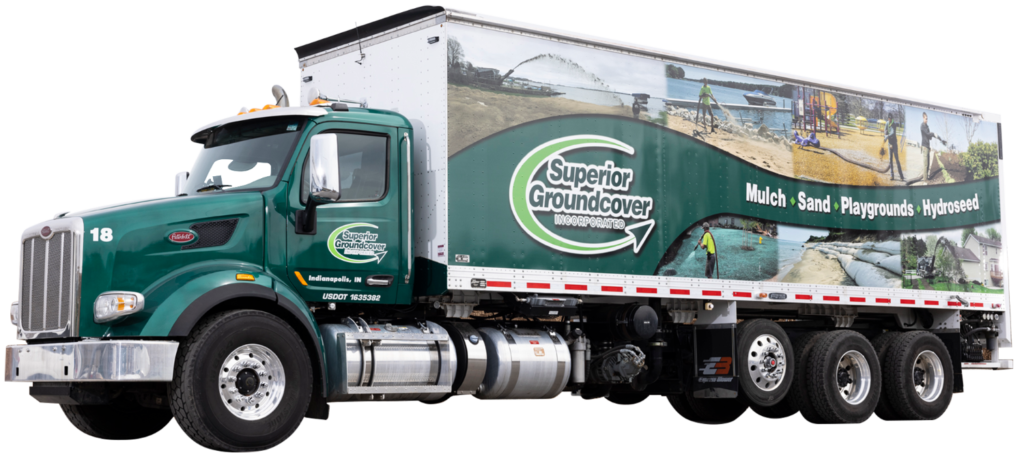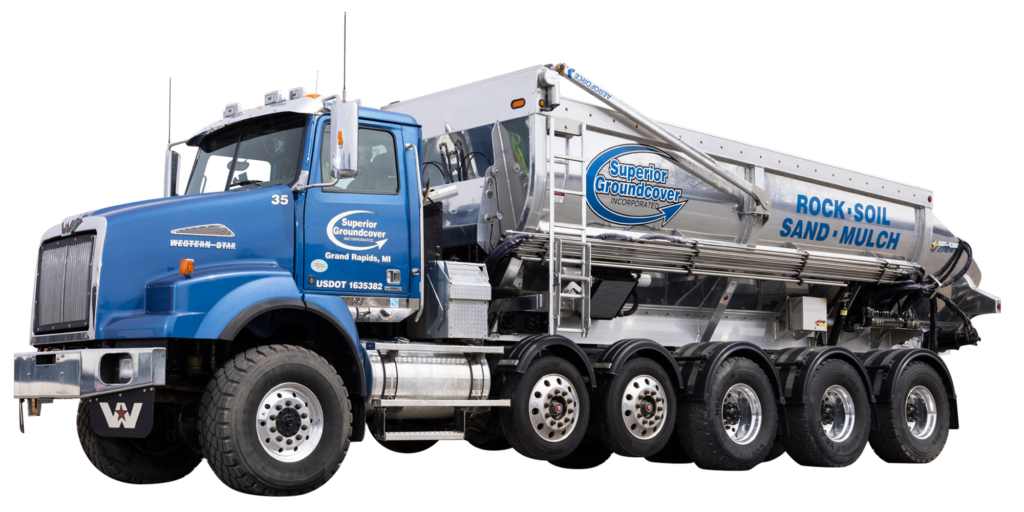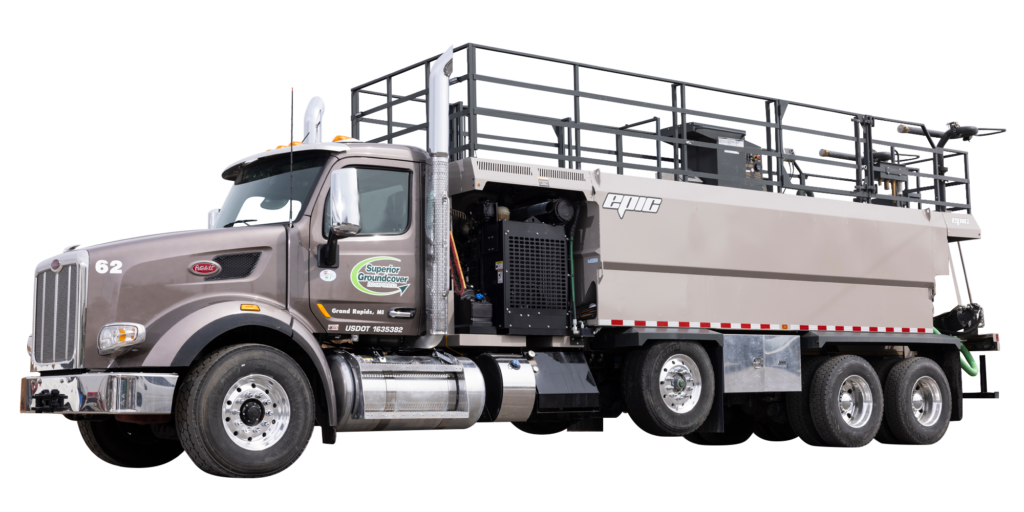This page compares and contrasts these three types of erosion control and materials; including efficacy, cost, environmental impact, and ease of deployment.
Table of Contents
Geotextile Tubes for Erosion


What are geotextile tubes?
Geotextile tubes are an erosion prevention tool that create a barrier along a shoreline. They are sometimes called breakwater tubes because they act as a breakwater to slow waves. When waves approach a shoreline, they hit the geotextile tube first, which reduces their speed and force. This reduces the erosive force on the dune or beach. Geotextile tubes can help preserve beaches.
Geotextile tubes are made out of a geotextile fabric, which is UV stabilized and able to withstand the elements. The fibers are strong enough to last through storms and other weather conditions, including Lake Michigan ice. They can be found in a variety of sizes to create the right barrier for the specific property.


How do geotextile tubes protect from erosion?
Geotextile tubes can protect property from erosion in many ways. They can be used for everything from land reclamation to island creation to dams.
“Additionally, geotextile tubes can be used as breakwater walls. They are able to absorb the impact from waves, diminishing their strength when they hit the shore and minimizing erosive patterns.
Geotextile tubes can be used to form seawalls. By stacking geotextile tubes, seawalls can be formed to help protect homes and property from storm waves and rising water levels.”
Learn more about Geotextile Tubes for Erosion.


Are geotextile tubes expensive to install?
Geotextile tubes vary in cost based on project size, system height, location, and other specific project site details. Most geotextile tube sites on Lake Michigan will likely cost between $200 – $400 per linear foot, including installation.
Do geotextile tubes harm the environment?
Geotextile tubes are, comparatively, a much better environmental solution than steel seawalls.
Revetments for Erosion
What are revetments?
Revetments are another erosion control method that can be either exposed structures or buried. Revetments are sloped and typically permeable. They are often made of natural stones or concrete blocks which help absorb wave energy (rather than simply reflect it). This makes them more environmentally friendly than steel seawalls.
Some advantages of revetments include:
- No wave flanking
- Less expensive
- More environmentally friendly
Some disadvantages of revetments include:
- The look is less appealing to some
- Maintenance / structural integrity
- Do not prevent flooding
How do revetments protect from erosion?
Revetments are passive structures which help protect against erosion by limiting damage from wave action, storm surge, and strong currents. Unlike seawalls, revetments do not prevent flooding.
Are revetments expensive to install?
Revetments may be less costly than seawalls, depending on materials and method of installation, but can still cost $2,000 or more per lineal foot. Costs can begin to add up with maintenance, however. Some types of revetments are not long-term solutions and do require maintenance.
What is the best material for revetments?
Revetments can be made out of many different materials including:
- Rip Rap, Revetment Stone, Armor Stone
- Gabions
- Wooden planks
- Logs
- Concrete blocks
Natural rip-rap rock revetments are common because they last longer and are more environmentally friendly.
Are revetments harmful to the environment?
Revetments cause less damage to the environment than seawalls because they do not cause wave flanking, however, they do still have adverse effects.
“Bulkheads and revetments greatly reduce the connectivity between land and aquatic ecosystems, with adverse impacts on species that utilize both habitats.”
—https://www.sciencedirect.com/topics/earth-and-planetary-sciences/revetment.
Any unnatural altering of the shoreline can damage the natural eco-systems. The best method for protecting your property from natural erosion is to build far enough away from the water and to leave natural vegetation where it is. Removing natural vegetation is essentially removing the erosion barrier. Natural vegetation has deep root systems which hold soil in place and absorb wave energy.
Seawalls for Erosion


What are Seawalls?
A seawall is a hard wall that is installed along the shoreline, which is intended to stop wave erosion. Seawalls can be made of many types of materials including concrete, wood, rock, and steel.
How do seawalls work to prevent or protect from erosion?
Seawalls are intended to protect the shoreline by preventing waves from hitting the shore. However, seawalls typically cause much more harm than good. Seawalls not only cause environmental problems, but actually worsen erosion.
“Seawalls also prevent the absorption of wave energy. When a wave hits a wall — rather than vegetation or soil — the energy is not absorbed, and therefore, is directed elsewhere. Usually, it goes downward toward the lake bottom, where it “scoops” out the soil there. This event is called “scour.” Scouring leads to more habitat loss AND makes the lake deeper until the seawall is no longer viable and the water undercuts it. Scouring also makes the water cloudy, algae-filled, and all together much less pleasant for lake life and people.” https://www.superiorgroundcover.com/shoreline-erosion-a-complete-guide/
Seawalls actually prevent the absorption of wave energy. When a wave hits a seawall instead of natural vegetation or soil, the energy merely bounces off the wall and is redirected outwards. Next, the wave heads toward a neighboring property and causes severe erosion damage to that property. This phenomenon is called “wave flanking.” Wave flanking begins a domino effect around the lake shore.
“When one seawall is installed, neighboring seawalls are required to handle the wave flanking, and a vicious and unnatural cycle continues to wreak havoc on the lakes.”


Are seawalls expensive to install?
The cost of seawalls varies based on a few different factors. These include soil condition, size of the wall, as well as job site accessibility. Soil condition determines from which materials the seawall should be constructed. Steel Seawalls can cost upwards of $2,000 per linear foot or more, but this can vary based on materials used.
To install a seawall, the construction team must first examine the area. They will need to note the soil condition, the water levels, and the surrounding environment in order to determine the materials and size of the wall.
Next the team will need to remove any type of old seawall if there is one. Following the removal of the old wall, they will determine the amount of posts needed. A post is typically needed every 6-8 feet.
The land along the shore is excavated, and then the posts are installed into the ground. The posts help to support the seawall. After the posts are installed, the seawall is constructed. Next, it is secured to the shore and backfilled with sand.
What are the best materials for seawalls?
Seawalls can be made of many different materials depending on soil conditions, budget, and other factors. Some of the common materials include:
- Timber
- Aluminum
- Steel
- Plastic
- Concrete
Do seawalls harm the environment?
As discussed above, seawalls have a negative impact on our environment. According to a study conducted by UC Santa Barbara, of the 207 ecological responses to seawalls that were catalogued, over 70% were “significantly negative.”
According to the Watershed Council’s guidebook on shoreline erosion: Understanding, Living With, and Controlling Shoreline Erosion: A Guidebook for Shoreline Property Owners Third Edition:
“Bulkheads have numerous disadvantages. When placed in the water or at the water’s edge, the vertical faces of bulkheads can reflect and transfer wave energy, causing increased bottom scouring in front of the structure and accelerated shoreline erosion beyond its end. The loss of a sand beach is often the result. Bulkheads are aesthetically unattractive and degrade shoreline habitat. They are rigid structures and cannot adapt to minor landscape movements. This means that they are usually doomed to eventual massive failure from the enduring forces of nature. They create access problems unless stairs are provided. They require heavy equipment and open accessibility at the site, and the installation can
be noisy and disruptive.”
Seawalls are among the most destructive actions to a lake ecosystem.
What is the best solution for erosion on shorelines and banks?
Shoreline erosion is a natural process that cannot be prevented. The best solution for protecting your property is (as explained above) to build far enough away from the coastline and to leave natural vegetation in place.
If needed, biological engineering can also help reduce the effects of erosion in an environmentally friendly way.
When emergencies like those facing residents along the Great Lakes occur, other methods may need to be implemented. Each solution described above has advantages and disadvantages.
To find the best solution for your unique situation, contact a member of our team!




